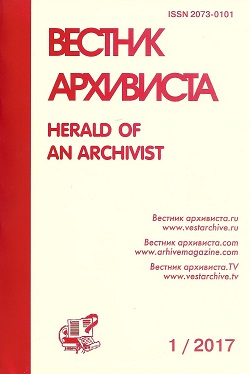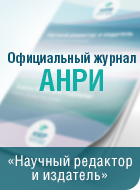Scientific article
doi 10.28995/2073-0101-2024-2-480-494
For citation
Yurganov, Andrei L'. (2024), “On the original version of the play "Fear" by Stalinist playwright Alexander Afinogenov. 1930s”, Herald of an Archivist, no. 2, pp. 480-494. doi 10.28995/2073-0101-2024-2-480-494
Yurganov, Andrei L'., Russian State University for the Humanities, Moscow, Russia
On the original version of the play "Fear" by Stalinist playwright Alexander Afinogenov. 1930s
Abstract
The article examines the work of Stalinist playwright Alexander Nikolaevich Afinogenov (1904-1941) through the prism of his complicity in the ideological campaigns of the Bolshevik Party. The study of the impact of party-state ideology on the broad masses of people during the Stalinist era is a priority direction of historical science. However, this direction needs further thematic and problematic expansion. The ideological campaigns of the Bolshevik Party in the 1930s found their artistic expression on the theatrical stage, in the plays of the most famous playwrights. This interaction between propaganda and theater art has not been studied sufficiently. There are practically no generalizing works. This is partly due to the fact that sufficient empirical material has not yet been accumulated. Almost every play by A. N. Afinogenov corresponded to one or another vector of the ideological struggle of the All-Union Communist Party of Bolsheviks. The play "Fear" (1931), which became a full-scale artistic expression of one of the most powerful ideological campaigns conducted by the Bolshevik Party until the time of the "Great Terror" - the campaign to "purge" state and party organs, is of particular interest. The original manuscript of this play, found in the Moscow Art Theatre Museum, significantly expands the understanding of how the play was understood by contemporaries. The initiator of the changes in the text of the play was K. S. Stanislavsky, who persuaded A. N. Afinogenov to introduce the figure of the "investigator" into the play. A. N. Afinogenov significantly remade the main pictures of the play - the eighth and ninth, in fact, they were rewritten anew. The play "Fear" was staged in two theaters - in the State Drama Theater (Leningrad) and in the Moscow Art Theater (Moscow). In Leningrad, where the performances began earlier than in Moscow, they used the original text of the play (at least until the end of 1931), and in Moscow used the revised version. This in no way contradicted A. N. Afinogenov, the playwright, who saw his work as a continuation of the ideological struggle in the artistic images of Soviet dramaturgy. In the found original version of the play and in the revised version there are different accents in the characterization of the characters of the play (in the eighth and ninth pictures, the final ones). But it was not the artistic side of the theatrical work that mattered, but the ideological basis, the meaning of which in both editions was reduced to the most important postulate of totalitarianism - to recognize the class basis of morality, to renounce oneself, one's views, one's "own" science, to erase one's former life in order to enter the "objective" state of collective unanimity without one's own personality.
Keywords
А. N. Afinogenov, play "Fear", Soviet dramaturgy, Moscow Art Theater Museum, State Drama Theater, Moscow Art Academic Theater, K. S. Stanislavsky, N. V. Petrov, Stalinism, totalitarianism, M. A. Bulgakov
Download the article: yurganov_doi
References
Anfertiev, I. A. (2020), Modernizatsiya sovetskoi? Rossii v 1920–1930-e gody: programmy preobrazovanii? RKP(b) – VKP(b) kak instrumenty bor'by za vlast': monografiya [The modernization of Soviet Russia in 1920-1930-ies: programs of transformations of the RCP(b) - All-Union Communist Party of Bolsheviks as tools of the struggle for power: monograph], INFRA-M, Moscow, Russia.
Afinogenov, A. N. (1977), Selected. In 2 vol. Т. 1. Pieces, articles, speeches / Introductory article by A. V. Karaganov. Comp. and notes by K. N. Kirilenko, V. P. Korshunova. Art, Moscow.
Venyavkin, I. G. (2010), “Writer Afinogenov's "self-inquiry": the search for literary form during the Great Terror”, in Yurganov, A. L. (ed.), Istochnikovedenie kul'tury: al'manakh. Vyp. 2 [Source study of culture: almanac. Issue 2], RSUH, Moscow, Russia, pp. 13-66.
Gorchakov, N. M. (1951), Rezhisserskie uroki K. S. Stanislavskogo. Besedy i zapisi repetitsii [Directing lessons of K. S. Stanislavsky. Conversations and records of rehearsals], Iskusstvo, Moscow. pp. 523-524.
Sarnov, B. M. (2000), “The Chariot of the Juggernaut: Chapters from the book of memoirs being prepared for printing”, Literatura, no. 11, pp. 5-12.
Strutinskaya, E. I. (2022), “Guillotine on the Soviet Stage in 1931 Scenography by N. P. Akimov for the play "Fear"”, Voprosy teatra. Proscaenium, no. 3–4, pp. 342-343.
Yurganov, A. L. (2023), “"Bobruisk case" and the play "Odd Man" by A. N. Afinogenov: socio-political realities of Stalinism and Soviet drama“, Russia and the contemporary world, no.2, pp.156-174.
Yurganov, A. L. (2018), Kul'turnaya istoriya Rossii. Vek dvadtsatyi. Stat'i i publikatsii raznykh let [Cultural History of Russia. Century of the twentieth. Articles and publications of different years], Tsentr gumanitarnykh initsiativ, Moscow, St. Petersburg, Russia, pp. 224-288.
Yurganov, A. L. (2020), Kul't Oshibki. Teoreticheskii front i Stalin. Seredina 20-kh – nachalo 30-kh gg. XX v. [The Cult of Error. Theoretical front and Stalin. Seredina 20-i - nachala 30-i gg. XX v.], Tsentr gumanitarnykh distsiplin, Moscow; St. Petersburg, Russia.
About the authors
Andrei L'. Yurganov, Doctor of Historical Sciences, Professor, Russian State University for the Humanities, Department of Russian History of the Middle Ages and Modern Times, Head of the Department, Moscow, Russia, 8-916-271-30-82, This e-mail address is being protected from spambots. You need JavaScript enabled to view it
ORCID 0000-0001-5409-2578
The article was received in the editorial office on 20.11.2023, recommended for publication on 20.03.2024.














